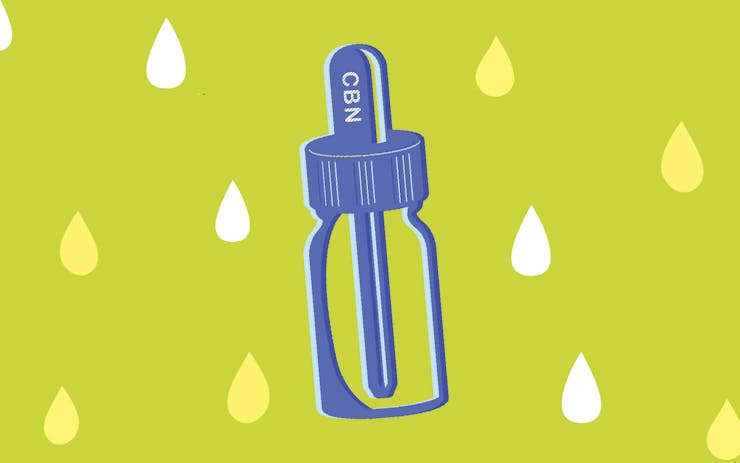Updated 7/30/19
If you use cannabis, you’ve probably heard all about it’s two most popular cannabinoids, THC and CBD. But these aren’t the only cannabinoids produced by the plant. You’ll also find minor cannabinoids, like CBN (cannabinol), among others.
These medicinal compounds, unique to cannabis alone, can be very different from each other in terms of their effects and medicinal benefits. So, if you want to know how your cannabis will affect you, learning about the different cannabinoids is the first step.
So, let’s get to know CBN a little better.
What are the potential benefits of CBN (cannabinol)?
CBN is a non-intoxicating compound that is best known as the cannabinoid created when THC ages. For that reason, it’s usually present in high amounts in older cannabis. While this might be a turn-off for some, others seek out older cannabis just to enjoy the effects of CBN.
Here are a few of the potential benefits of CBN currently being explored in research. Keep in mind, current research on CBN is limited with very few studies demonstrating its effects in the human body.
Antibacterial
Studies on CBN have found that it may be a potent antibacterial agent. In lab settings, CBN was tested on strains of MRSA bacteria that are resistant to traditional antibiotics. Researchers found it to be a potent antibacterial agent against these resistant strains. Perhaps in the future, we will see CBN being used to fight off bacterial infections that our usual antibiotics can’t heal.
Neuroprotectant
CBN may also be a powerful neuroprotectant. In one rodent study, researchers used CBN as a treatment for ALS and found that it was able to delay the onset of the condition. While human studies need to be done, this suggests that CBN may provide a powerful tool in the fight against ALS and other neurodegenerative conditions.
Appetite stimulation
In rodent studies, CBN increased the amount of food that rat subjects ate, suggesting that it could be an effective appetite stimulant. Since some avoid THC (another well-known appetite stimulant) due to its intoxicating effects, CBN could potentially offer an alternative for those seeking the munchies without the high—but more research is needed.
Glaucoma
CBN may also be helpful for those suffering from glaucoma. One study on rabbits found that CBN (as well as THC) reduces intraocular pressure—the biggest risk factor for glaucoma. Still, research is in early stages and CBN hasn’t been shown to be superior to other glaucoma medications. More research is needed to know if cannabinoids could ever effectively replace any traditional treatments for glaucoma.
Shop highly rated dispensaries near you
Showing you dispensaries nearAnti-inflammatory
CBN may also be a potent anti-inflammatory agent capable of helping those with rheumatoid arthritis. In one rodent study, CBN was shown to reduce arthritis. While more research needs to be done, this could end up being an incredible help to those suffering from this debilitating condition.
Popular misconceptions about CBN
If you’ve read about CBN before, you may be surprised that you didn’t see “insomnia” on the list of medical benefits above. CBN is often praised as a super-sedative, but reputations can be deceiving.
Although there hasn’t been much research on CBN’s sedating effects (or lack thereof), one human study did look at this question back in the 1970s. While the study was small, none of the respondents reported that CBN made them feel sleepy.
So why does everyone say that it’s sedating?
Well there are two possible reasons, and they both lead back to one source: People noticed that older cannabis (which is high in CBN) makes them sleepy and assumed it must be the CBN.
First, it may be that the combination of CBN and THC is what actually causes the sedative effect.
In the same study that found CBN didn’t make subjects sleepy, researchers tested CBN alone, CBN with THC, and THC alone. While THC produced some drowsiness on its own, the combination of the two produced even higher levels of drowsiness. So perhaps those enjoying high CBN cannabis, which also contains THC, have noticed the synergistic effects and assumed the sedative effect was attributable to the CBN alone.
In other words, the older cannabis that is high in CBN is also high in sedating terpenes. These terpenes, rather than the CBN, could account for the sedative effects.
But even without the THC connection, there may be other factors which cause higher CBN cannabis to be sedating.
“Pure CBN is not particularly sedating,” explains leading cannabis researcher and neurologist Dr. Ethan Russo, “But it is typically found in aged cannabis in which the monoterpenoids have evaporated leaving the more sedating oxygenated sesquiterpenoids. This accounts for the discrepancy.”
In other words, the older cannabis that is high in CBN is also high in sedating terpenes (other active chemicals in the plant). These terpenes, rather than the CBN, could account for the sedative effects.
While CBN may not be sedating on its own, you may be able to take advantage of its synergistic effects with THC to get the sleep inducing effects you are looking for.
Another misconception about CBN is that high CBN products will always be non-intoxicating. While CBN alone is non-intoxicating, it can actually increase euphoric effects of THC. If you are looking to take advantage of CBN’s benefits without a high, make sure you are using products that don’t contain much THC.
How to find CBN (cannabinol) cannabis products
While CBN isn’t particularly plentiful in fresh or cured cannabis, it can often be found in older cannabis, particularly cannabis that has been exposed to a lot of oxygen. CBN is actually created from THC when it is oxidized (exposed to oxygen over time).
Still, leaving your cannabis out in the open air might not be the most efficient way of getting CBN. Brands are beginning to offer products with isolated CBN, usually in the form of tinctures or edibles (and, ironically, marketed as sleep aids). These pure CBN products are a great way to test out the cannabinoid yourself and see if it’s helpful for you.





